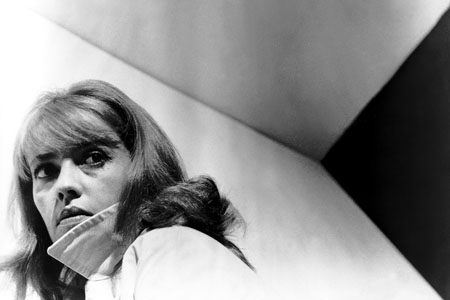Today, as Jeanne Moreau turns 85, is an excellent day to turn to Jeff Galipeaux‘s fine and lengthy 2001 profile for Salon. She’d “spent half of the 20th century on screen. From one Age of Anxiety to another, she has appeared in more than 110 films and dozens of plays. She is, as she likes to say, ‘a woman with absolutely no sense of nostalgia.’ … In her four best performances from the ’60s, Moderato Cantible, Eva, Mademoiselle, and La Notte, Moreau demonstrates a broader range than most actresses do in their entire careers. And that’s leaving out Jules and Jim, The Immortal Story, Bay of Angels, Chimes at Midnight, Diary of a Chambermaid, The Bride Wore Black and a half-dozen other films. She is the heavyweight of ’60s cinema,” and of course, she’s kept right on going. Just last year, she appeared in Manoel de Oliveira‘s Gabo and the Shadow, and the IMDb has pencilled her in as Nina (“rumored”) in Joseph Morder’s forthcoming La Duchesse de Varsovie.
Galipeaux and Moreau’s conversation covers a lot of ground, but there’s quite a bit of dwelling on Orson Welles: “Moreau fast became his favorite pinch hitter. She appeared in three complete films and one aborted project, which for a Welles collaborator must be some kind of record. First, in 1962, she had the small role of Miss Burstner in his underrated film of Kafka’s The Trial, throwing a tantrum that reduces Anthony Perkins to mush, and finally garnering one of the best close-ups in any Welles film, magnificently framed as she shrieks, ‘Get out of my room!’ Then, in 1965, Moreau played Doll Tearsheet, in all her unexpurgated glory, cuddling with Welles’s Falstaff in Chimes at Midnight. Three years later she was cast as Virginie, wife of Welles’s curmudgeonly Mr. Clay in The Immortal Story, his first film in color; a subdued, perfect 58-minute miniature originally shot for television, but given a European theatrical release. Finally, she was Rae Ingram in his The Deep, shot intermittently off the coast of Yugoslavia between 1968 and 1973, when the production was aborted, following the death of costar Lawrence Harvey…. Welles called Moreau ‘the greatest actress in the world’ and the admiration was mutual.”
From Louis Malle’s Ascenseur pour l’échafaud (1958)
Her Wikipedia entry not only lists her awards—the César, a BAFTA Award for Best Foreign Actress, a Cannes Best Actress Award, “and several lifetime awards”—but also notes that her personal life has been nearly as richly storied as her career: “Moreau has maintained friendships with prominent writers such as Jean Cocteau, Jean Genet, Henry Miller, and Marguerite Duras (an interview with Moreau is included in Duras’s book Outside: Selected Writings). She has been married twice, once to Jean-Louis Richard (1949–1964) and then to American film director William Friedkin (1977–1979). Director Tony Richardson left his wife, Vanessa Redgrave, for her in 1967, but they never married. She has also dated directors Louis Malle and François Truffaut, fashion designer Pierre Cardin, and Theodoros Roubanis, a Greek actor/playboy.” NewWaveFilm.com has a fuller biography; and you’ll find a birthday salute in today’s Frankfurter Allgemeine Zeitung and a few clips in Il Post.
For news and tips throughout the day every day, follow @KeyframeDaily on Twitter and/or the RSS feed. Get Keyframe Daily in your inbox by signing in at fandor.com/daily.




